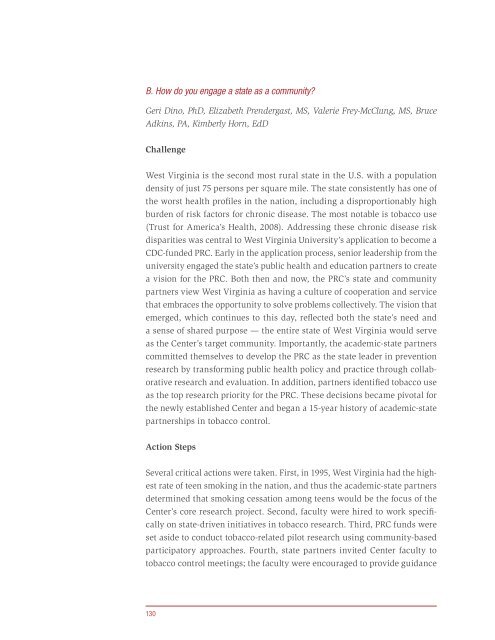Principles of Community Engagement (Second Edition)
Principles of Community Engagement (Second Edition)
Principles of Community Engagement (Second Edition)
Create successful ePaper yourself
Turn your PDF publications into a flip-book with our unique Google optimized e-Paper software.
B. How do you engage a state as a community?<br />
Geri Dino, PhD, Elizabeth Prendergast, MS, Valerie Frey-McClung, MS, Bruce<br />
Adkins, PA, Kimberly Horn, EdD<br />
Challenge<br />
West Virginia is the second most rural state in the U S with a population<br />
density <strong>of</strong> just 75 persons per square mile The state consistently has one <strong>of</strong><br />
the worst health pr<strong>of</strong>iles in the nation, including a disproportionably high<br />
burden <strong>of</strong> risk factors for chronic disease The most notable is tobacco use<br />
(Trust for America’s Health, 2008) Addressing these chronic disease risk<br />
disparities was central to West Virginia University’s application to become a<br />
CDC-funded PRC Early in the application process, senior leadership from the<br />
university engaged the state’s public health and education partners to create<br />
a vision for the PRC Both then and now, the PRC’s state and community<br />
partners view West Virginia as having a culture <strong>of</strong> cooperation and service<br />
that embraces the opportunity to solve problems collectively The vision that<br />
emerged, which continues to this day, reflected both the state’s need and<br />
a sense <strong>of</strong> shared purpose — the entire state <strong>of</strong> West Virginia would serve<br />
as the Center’s target community Importantly, the academic-state partners<br />
committed themselves to develop the PRC as the state leader in prevention<br />
research by transforming public health policy and practice through collaborative<br />
research and evaluation In addition, partners identified tobacco use<br />
as the top research priority for the PRC These decisions became pivotal for<br />
the newly established Center and began a 15-year history <strong>of</strong> academic-state<br />
partnerships in tobacco control<br />
Action Steps<br />
Several critical actions were taken First, in 1995, West Virginia had the highest<br />
rate <strong>of</strong> teen smoking in the nation, and thus the academic-state partners<br />
determined that smoking cessation among teens would be the focus <strong>of</strong> the<br />
Center’s core research project <strong>Second</strong>, faculty were hired to work specifically<br />
on state-driven initiatives in tobacco research Third, PRC funds were<br />
set aside to conduct tobacco-related pilot research using community-based<br />
participatory approaches Fourth, state partners invited Center faculty to<br />
tobacco control meetings; the faculty were encouraged to provide guidance<br />
130

















